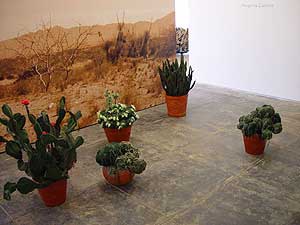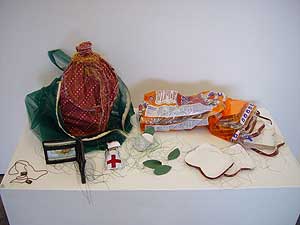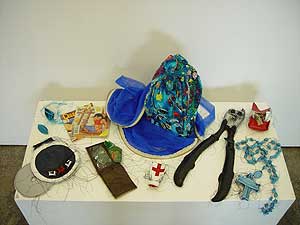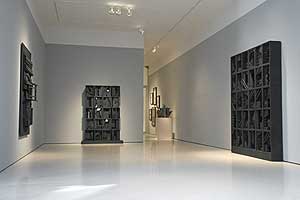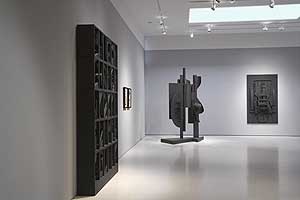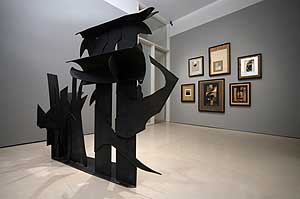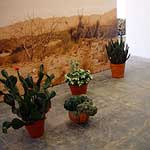Meredith Goldsmith, a current Critical Studies Core Fellow at the Glassell School of Art, examines two recent sculpture exhibitions in Houston:
Margarita Cabrera at Finesilver Gallery, and Louise Nevelson at McClain
Gallery.
Below are her impressions of each exhibition side-by-side, generating a textual conversation between the two female sculptors. Readers are invited to express their own connections with, and ideas about, both artists and their works.
Corporeal Consequences of the Idea of a Line
On a hot Saturday, I walked from my apartment to Finesilver Gallery in Houston carrying a small backpack, which contained my notebook, two ballpoint pens, and other personal effects (wallet, keys…). Eleanor Williams, Finesilver’s director here, kindly offered me a bottle of water, which I accepted and drank as I circled around a 10-foot-high white wall to find Margarita Cabrera’s installation.
The tools of my purpose appeared to echo the items in Backpack (blue) and Backpack (green), two sculptures from 2006. And yet any affinity I recognized between my backpack and Cabrera’s was swiftly dispelled by my very movements in the gallery, by the subtlety of access. I walked freely among the artist’s sculptural interpretations of backpacks, cacti, and a desert vista. Cabrera sews sculptures of everyday objects out of industrial fabrics whose specificity and material variously address the social bodies produced by the economic and political relationship between Mexico and the United States. In her installations, Cabrera creates a situation in which a gallery patron acts out and experiences her own privilege among objects derived from the oppression of others, circumstances where the interdependence of art and audience is augmented by the interdependence of first and third worlds, while revealing the corporeality of all.
Cabrera’s forms recall Claes Oldenburg’s soft sculptures, not only because of their style and consumer subject matter, but because they refer to the body. Oldenburg’s works and other pop art address an overt American obsession with stuff as well as a covert obsession with the body. Artists in the 1970s to the 1990s expanded the investigation of the latter obsession to include skin color and language. (“Identity politics” is a piece of art historical rhetoric that could only have emerged in the hyper-racial United States.) Like her contemporaries, Cabrera has expanded this critical territory further to include the art object and the gallery, as well as labor (hers and that of the workers in the post-NAFTA auto and textile industries).
Backpack (green) and Backpack (blue) consist of sewn mesh backpacks and other sewn, soft sculptures removed from the unzipped bags and displayed on a shelf, as if they had been recovered from the desert (or have some such constructed past) and are now part of a natural history museum exhibit. Beside the blue pack lies a round CD player with a gray disc peeking out, an empty wallet, a baby-blue rosary with a fist-sized cross, and a gallon-sized jug whose fabric features deep blues and colorful tropical fish. Also arrayed as possible contents are a large pair of black and gray wire-cutters and some small tan-tipped cigarettes held in an open pack with a geometric red and white design. Additionally, there are two ready-mades: pornographic comic books. The comic books, the disc player and the jug’s fabric print invite the viewer to surmise that Backpack Blue once belonged to an adolescent.
The green pack’s accoutrements include an empty wallet, a prayer card with a saint, and two tiny Jesus of the Sacred Heart tiles on a strand, designed to be worn as a protective necklace during travel. These religious objects are ready-mades, as is a plastic bag advertising the loaf of bread it contained before Cabrera appropriated it. She has replaced the original bread with her own slices, hand-sewn from white and brown vinyl.
These backpack sculptures are two from a series based on border crossing stories, derived from objects people said they were glad to have or wished they had brought for the journey. It is as if Cabrera has packed for a fictional man and a boy who is perhaps his son, both perhaps her loved ones. In addition to the jugs for water, she has included garlic bulbs (white with individual cloves sewn in blue and green for each pack), which, I am told, are rubbed on the shoes of the traveler to prevent snakebites. And each pack is equipped with a white container the size of a pill bottle that is emblazoned with a red cross indicating medicine.
Cabrera leaves her trailing threads long when she sews, so that the sculptures look almost hairy, definitely raw and unfinished, and perhaps hurried. It makes them appear delicate—the proverbial loose thread, so easy, even enticing, to tug, yet our imagining of the consequent mess keeps the urge in check. But are these arrangements, these protective vessels, any more functional because we resist that urge? The artist quickly raises the stakes, forcing viewers to tackle the ideologies that produced these objects (as art and as representations) and the bodies that engage with them (including those of viewers). She uniquely materializes critic Nicholas Bourriaud’s description of social aesthetics as “the group pitted against the mass, neighborliness against propaganda, low tech against high tech, and the tactile against the visual”. [1.]
In Cabrera’s other sculptures at Finesilver, the loose threads become the flaccid spiny needles of different cactus species. Just as the presentation of Backpack (green) and Backpack (blue) denotes an archival interface, these cactus specimens are isolated as if for study (their scientific names are their titles), even as they are appropriated for decoration. Cabrera sews and stuffs each species from the forest green canvas of Border Patrol uniforms. Barrel Cactus #1 and Barrel Cactus #3 bubble over the rims of their folksy terra-cotta pots, the latter including an embroidered badge in gold thread. In Nopal Con Tunas #4, the plant appears as successive budding paddles, each stiff and flat, with bursts of pink and red thread amidst the utility fasteners, pockets, buttons and drawstrings inherent to the uniform material. Yucca #2’s pot features a simple, graphic flower in relief, positioned as if it grew from where the base of the pot meets the ground; like all of the pots in this series, it is marked in the tradition of mass-produced household items made for the consumer-colonizer — with just enough detail to be recognizable and exotic.
Cabrera has arranged these sculptures on the cement floor in front of a sepia photograph printed on wallpaper. Slightly textured with a bit of sheen, it covers the entire 10 x 12-foot freestanding wall. Titled Wallpaper (2007), the piece offers a life-sized view of a dusty desert landscape. It is a vista covering a barrier. Here the viewer has the luxury to walk beyond the white wall she met upon her entrance.
Remnants of Modernism
Louise Nevelson (1899 – 1988) regularly wore three pairs of fake lashes on each eyelid, which made her amazing to look at, but must’ve made it difficult for her to see (though I do appreciate it as a poetic response to being cast as a “woman artist” — and a woman sculptor, at that).
The exhibition at McClain Gallery of some of her previously unseen works is the outcome of several relationships — some close, some productive, and some hostile. A McClain associate told me that after Nevelson’s death, disagreements between Nevelson’s son and her longtime studio assistant prevented works in her estate from being owned outright or shown. Recently, these disputes became moot when three galleries came together to purchase the estate. One of the three, PaceWildenstein of New York, has a close relationship with McClain Gallery, so Houston audiences were given the opportunity to view and purchase these sculptures and collages. The Jewish Museum in New York mounted a concurrent retrospective of Nevelson’s works, and a coffee-table book dealing specifically with her sculptures was also just published, making making this work even more desirable to Houston collectors.
All of this is to say that the objects on view at McClain are not on display because they make a new argument about Nevelson’s practice; rather this is what is left to sell. On the one hand, the resolution of the disputes of ownership has made their viewing possible. On the other hand, as soon as they’re out of this show, they’ll be in the homes of collectors, largely lost to audiences again. In fact, when I visited the show late in its run, several collages had already been removed to their new owners’ walls. What I did view were Nevelson’s collages, her wall-hung and freestanding sculptures, and maquettes for some of her public artwork, ranging from 1957 to the early 1980s.
Next to the sculptures, her collages seem to operate like drawings: she used similar bits of cardboard, packaging, scraps of paper, thin wood veneers and thicker chunks of textured bark to make them. Nevelson gained art world acclaim in the late 1950s and 1960s with other assemblage artists in New York like Robert Rauschenberg and Jasper Johns. The difference between their kind of assemblage and that of the West Coast artists is that New Yorkers were using trash to make something that was still undeniably recognizable as fine art—therein lies the edge. Californians (Bruce Conner, Ed Kienholz and others) were also interested in using trash, but to make things that were utterly oppositional to fine art. Their works are still difficult to look at, whereas Nevelson’s collages are not. The spaces articulated between the elements in each work are remarkable. The curve of the splinter-thin piece of wood placed against a black board in Untitled (1959) is captivating, and other pieces contain balanced, pleasantly surprising arrangements among the remnants, including the way they relate to each artwork’s steady outer edges. These works recall the modern artist as creator of isolated worlds, and the modern viewer as the art’s solitary activator. The palpable tensions in Nevelson’s work are otherwise unconnected to anything else on earth.
This is different from her large sculptures. Nevelson’s wooden sculptures cleave to the gallery wall, neither architecture nor object. It is as if the artist or the sculpture itself is too anxiety-ridden to occupy more of the room. The works here are part of a series that deliberately references furniture and domestic architecture. Their uniform color and composition denies them specificity and makes them more like a memory of a space and household belongings — or a manifestation of a cognitive system, absorbing the gaze as it absorbs all light and color. A Nevelson quote stenciled on the wall reads:
“But when I fell in love with black, it contained all color. It wasn’t a negation of color. It was an acceptance. Because black encompasses all colors… For me this is the ultimate. You can be quiet and it contains the whole thing. There is no color that will give you the feeling of totality…”
We may hesitate to buy this idea, but Silent Music II (1964) makes her argument stick. Here we find a sculpture that resembles a bookcase with 20 rectangular compartments arranged in a 4 x 5-foot grid, occupied by various wooden bits that recall domestic elements. There are lathed spindles, pieces of molding and two cylinders with curling filigree reminiscent of feathers or fronds—in fact, in this composition they resemble potted plants or floral arrangements among the other knickknacks. Each compartment is precisely composed with wooden shapes tightly placed, much like a dense forest—compelling, if difficult, for the eye to penetrate and parse out. In several places, we have a clear view to the back of a box, where Nevelson placed mirrors reflecting pieces of our bodies back to us. In this arrangement, Nevelson’s description of black as all present appears pointedly true, albeit counterintuitive. The reflective surface holds light, but seems to absorb it completely, and each mirror appears as a source of light, yet gives none of it away. The mirrors appear to be the most negative of spaces, between and behind the flat black mass. Since these mirrors hold our reflections, it is a disturbing negation.
The black also references Rorschach inkblots, adding a psychological component that works in concert with the bits of recognizable chairs, banisters and other objects associated with homes. (This is especially apparent in the hanging sculptures, all black against the gallery walls.) All of Nevelson’s works are so much about intuition and the inner life, what accumulates, what is left behind, rather than a representation of the specific.
This show exemplifies Nevelson’s constant creation and her additive method. “I’ve come to recognize that the way I think is collage,” she once said, and it is interesting to consider her work’s tendency toward fragmentation and its relational nature (this remnant becomes different when put next to this one, etc). It recalls an idea the poet H.D. had while in analysis with Sigmund Freud as Europe was gearing up for World War II: she realized that, either because she was a woman or because of the trauma she suffered during the First World War, or both, she was psychologically fragmented and destined never to be whole. But rather than despairing at her lot (or in addition to that despair), H.D. claimed this as a position from which to write poetry. I found myself thinking about Nevelson’s life — her family leaving Europe when she was a child, her conflicted motherhood, her recognition only when she was in her sixties (alongside male artists in their twenties) — in the context of her making monuments from fragments. Perhaps the condition of being fractured and seeking wholeness is what propels creative work.
1. Hal Foster et. al, Art Since 1900 [New York: Thames & Hudson, 2004], 667
Images courtesy Finesilver Gallery and McClain Gallery
Meredith Goldsmith is a writer and current Critical Studies Fellow at The Core Program in Houston.


